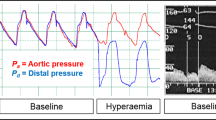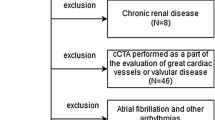Summary.
It is accepted that the assessment of the global cardiac risk for the occurrence of a coronary event is basically for preventive strategies. In a retrospective study, we have estimated the initial 10-year risk in 54 consecutive men (mean age 53.1 years) without clinically coronary artery disease (CAD) by using the PROCAM Score Scheme and the FRAMINGHAM Scoring System. All individuals underwent coronary angiography for diagnostic reasons. Inclusion criteria were angiographically normal coronary arteries or coronary vessels with minimal arteriosclerosis (luminal diameter reduction <35%).The extent of initial coronary arteriosclerosis was estimated semiquantitatively by the number of wall changed vessel segments S (proximal, medial, distal) of the 3 large epicardial coronary arteries. Individuals were devided into 3 risk categories with a 10-year risk/PROCAM <5% (gr. I), 5–20% (gr. II) and >20% (gr. III). The mean 10-year risk/PROCAM and FRAMINGHAM of the entire group was 14.0 and 14.1%, respectively. The number of vessel segments with minimal arteriosclerosis averaged S=2.6. There was a significant linear relation between the number of arteriosclerotic segments, grouped by S=0, 1–2, 3–4, >4 and the mean corresponding 10-year risk/PROCAM (r=0.97; p<0.025). The mean 10-year risk/PROCAM and FRAMINGHAM in gr. I was 2.1±1.1 and 5.1±3.5%, in gr. II 11.1±4.4 and 14.5±7.1% and in gr. III 25.4±3.3 and 20.4±6.2%, respectively (gr. I vs II vs III: p<0.005). In gr. I an average of S=0.8±1.4 segments, in gr. II of S=2.4±1.8 and in gr. III of S 4.1±1.8 vessel segments revealed initial coronary arteriosclerosis (gr. I vs II vs III: p<0.01 <0.0025, respectively). In 42 of the 54 men (78%) there were 10-year follow-up data regarding sudden cardiac death, fatal and non-fatal myocardial infarction available. Thirty-two men of the follow-up group (78%) showed no cardiac event (gr. A, mean age 53.3±8.3 years). In 10men (23.8%, 95% CI 19.7–32.5%) a fatal or non-fatal event occurred (gr. B, mean age 55.6±7.5 years). At the beginning of the study, the 10-year risk/PROCAM and FRAMINGHAM in gr. A was 12.0±9.3 and 14.1±8.0%, respectively. In gr. B the estimated 10-year risk was 18.7±8.0% (gr. A vs B: p<0.025) and 17.6±7.6%, respectively (gr. A vs B: p=ns). No cardiac event occurred in the low risk group <5% (mean 2.4±1.2%). In 23.8% (95% CI 19.2–36.8%) of the group with mild or moderate risk (5–20%, mean 10.4±4.1%) and in 38.5% (95% CI 29.5–53.1%) of the high risk group (>20%, mean 25.6±3.3%) a fatal or non-fatal event occurred. The total cardiac mortality was 7.1% (95% CI 6.6–15.1%). Our study indicates that men mean aged 53 years without clinical CAD and with a high 10-year risk (>20%), judged by the PROCAM Score Scheme, have a high probability of subclinical coronary arteriosclerosis and for the occurrence of a cardiac event. Thus, a strict distinction between primary and secondary prevention does not seem to be justified any more.
Zusammenfassung.
Die Beurteilung des globalen kardialen Risikos für das Auftreten eines koronaren Ereignisses ist heute als Grundlage präventiver Strategien anerkannt. Wir haben retrospektiv bei 54 konsekutiven Männern (mittleres Alter 53,1 Jahre) ohne klinisch manifeste koronare Herzkrankheit (KHK), bei denen zur definitiven Diagnosestellung eine Koronarangiographie erfolgte, zum Untersuchungszeitpunkt mit dem PROCAM-Score-Schema und dem FRAMINGHAM-Scoring-System das globale 10Jahresrisiko bestimmt. Einschlusskriterien waren angiographisch normale oder minimal arteriosklerotisch veränderte Koronargefäße (luminale Einengung <35%). Die Arterioskleroseausdehnung wurde semiquantitativ nach der Anzahl S betroffener Gefäßsegmente (proximal, medial, distal) der 3 großen epikardialen Koronararterien bestimmt. Es wurden drei Risikokategorien mit einem 10Jahresrisiko/PROCAM <5% (Gr. I), 5–20% (Gr. II) und >20% (Gr. III) gebildet. Das durchschnittliche 10Jahresrisiko /PROCAM und FRAMINGHAM des Gesamtkollektivs betrug 14,0 bzw. 14,1%. Im Mittel waren S=2,6 Gefäßsegmente minimal arteriosklerotisch verändert. Zwischen der Anzahl durchschnittlich betroffener Gefäßsegmente, gruppiert in S=0, 1–2, 3–4, >4, und dem entsprechenden mittleren 10 Jahresrisiko/PROCAM bestand eine signifikante lineare Beziehung (r=0,97; p<0,025). Das durchschnittliche 10Jahresrisiko/PROCAM und FRAMINGHAM in Gr. I betrug 2,1±1,1 bzw. 5,1±3,5%, in Gr. II 11,1±4,4 bzw. 14,5±7,1% und in Gr. III 25,4±3,3 bzw. 20,4±6,2% (Gr. I vs. II vs. III: p<0,005). In Gr. I waren S=0,8±1,4, in Gr. II S=2,4±1,8 und in Gr. III S=4,1±1,8 Gefäßsegmente arteriosklerotisch verändert (Gr. I vs. II vs. III: p<0,01 bzw. <0,0025). Von 42 der 54 männlichen Individuen (78%) lagen nach 10 Jahren Langzeitbeobachtungsdaten vor. 32 der 42 Männer (76,2%, mittleres Alter 53,3±8,3Jahre) hatten kein kardiales Ereignis erlitten (Gr. A), bei 10 Männern (23,8%, 95% CI 19,7–32,5%; mittleres Alter 55,6±7,5 Jahre) waren plötzlicher Herztod, tödlicher oder nicht tödlicher Myokardinfarkt aufgetreten (Gr. B). Die kardiale Gesamtmortalität betrug 7,1% (95% CI 6,6–15,1%). Bei Studienbeginn betrug das 10Jahresrisiko/PROCAM und FRAMINGHAM in Gr. A 12,0±9,3 bzw. 14,1±8,0% und in Gr. B 18,7±8,0% (Gr. A vs. B: p<0,025) bzw. 17,6±7,6% (Gr. A vs. B: p=ns). In der Niedrigrisikogruppe (<5%, im Mittel 2,4±1,2%) trat in 10 Jahren kein Ereignis auf, bei mittlerem Risiko (5–20%, im Mittel 10,4±4,1%) traten in 23,8% (95% CI 19,2–36,8%) und in der Hochrisikogruppe (>20%, im Mittel 25,6±3,3%) in 38,5% (95% CI 29,5–53,1%) Koronarereignisse auf. Unsere Untersuchung zeigt, dass Männer im mittleren Alter von 53 Jahren mit hohem 10Jahresrisiko (>20%), ermittelt anhand des PROCAM-Score-Schema ohne klinisch manifeste KHK bereits mit hoher Wahrscheinlichkeit eine subklinische Koronararteriosklerose aufweisen und ein kardiales Ereignis entwickeln. Eine strikte Trennung von Primär- und Sekundärprävention erscheint daher nicht berechtigt.
Similar content being viewed by others
Author information
Authors and Affiliations
Additional information
Eingegangen: 2. Oktober 2002 Akzeptiert: 17. Januar 2003
Correspondence to R. Wolf
Rights and permissions
About this article
Cite this article
Schulz, H., Sinn, R. & Wolf, R. Kardiales Risiko bei Männern mit angiographisch normalen oder minimal arteriosklerotisch veränderten Koronararterien. Z Kardiol 92, 245–253 (2003). https://doi.org/10.1007/s00392-003-0923-6
Issue Date:
DOI: https://doi.org/10.1007/s00392-003-0923-6




